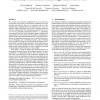Free Online Productivity Tools
i2Speak
i2Symbol
i2OCR
iTex2Img
iWeb2Print
iWeb2Shot
i2Type
iPdf2Split
iPdf2Merge
i2Bopomofo
i2Arabic
i2Style
i2Image
i2PDF
iLatex2Rtf
Sci2ools
PPOPP
2012
ACM
2012
ACM
Internally deterministic parallel algorithms can be fast
The virtues of deterministic parallelism have been argued for decades and many forms of deterministic parallelism have been described and analyzed. Here we are concerned with one of the strongest forms, requiring that for any input there is a unique dependence graph representing a trace of the computation annotated with every operation and value. This has been referred to as internal determinism, and implies a sequential semantics—i.e., considering any sequential traversal of the dependence graph is sufficient for analyzing the correctness of the code. In addition to returning deterministic results, internal determinism has many advantages including ease of reasoning about the code, ease of verifying correctness, ease of debugging, ease of defining invariants, ease of defining good coverage for testing, and ease of formally, informally and experimentally reasoning about performance. On the other hand one needs to consider the possible downsides of determinism, which might include...
Dependence Graph | Distributed And Parallel Computing | PPOPP 2012 | Programming Paradigms | Sequential Semantics |
| Added | 25 Apr 2012 |
| Updated | 25 Apr 2012 |
| Type | Journal |
| Year | 2012 |
| Where | PPOPP |
| Authors | Guy E. Blelloch, Jeremy T. Fineman, Phillip B. Gibbons, Julian Shun |
Comments (0)

